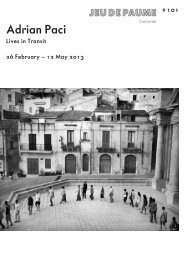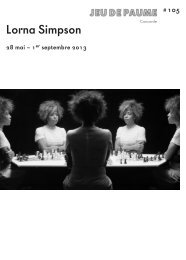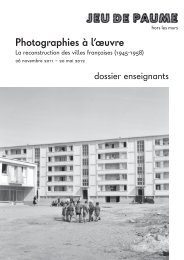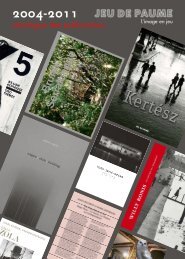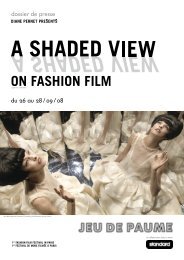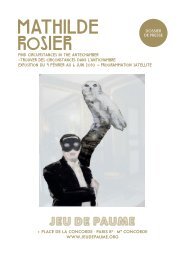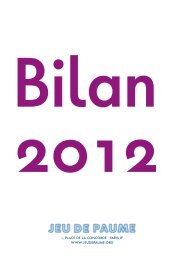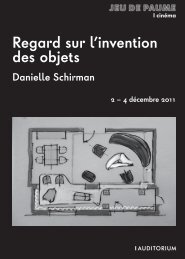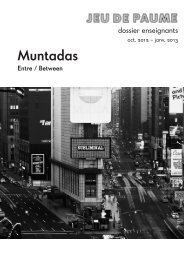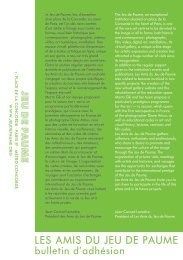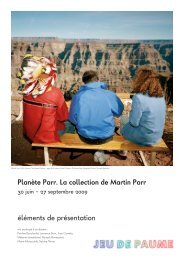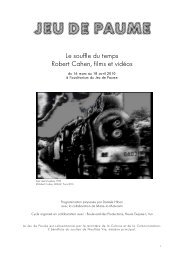Bruno Serralongue - Jeu de Paume
Bruno Serralongue - Jeu de Paume
Bruno Serralongue - Jeu de Paume
You also want an ePaper? Increase the reach of your titles
YUMPU automatically turns print PDFs into web optimized ePapers that Google loves.
# 69<br />
<strong>Bruno</strong> <strong>Serralongue</strong><br />
Campfires<br />
29 June – 5 September 2010<br />
Concor<strong>de</strong>
Inconnu, Las Vegas<br />
Series: “Destination Vegas,” 1996<br />
Hélène Retailleau Collection, Paris<br />
“For me, photography does not come first.<br />
It is mediated. It comes as a second phase,<br />
after thought, after putting in place the<br />
framework that <strong>de</strong>fines the rules.”<br />
<strong>Bruno</strong> <strong>Serralongue</strong> (France, 1968) started out on<br />
his career in the 1990s after completing his studies<br />
at Villa Arson, Nice, and the École Nationale<br />
Supérieure <strong>de</strong> Photographie in Arles (he also has<br />
an MA in art history). Taking into account the<br />
specificities of photography, its history, use and<br />
status, he has <strong>de</strong>veloped a distinctive body of<br />
work which questions the truth of photographic<br />
representation on the basis of a very precise<br />
working method that enables him to analyse the<br />
ways in which images are produced, disseminated<br />
and circulated in today’s world. Before going into<br />
the field, he gathers information published in the<br />
media, using reports from the press, Internet, and<br />
television and radio news, the way news agency do,<br />
then “commissions” his own images. “My very own<br />
Agence France Presse are the newspapers<br />
and bulletins that are accessible to rea<strong>de</strong>rs/viewers.<br />
I therefore don’t have access to the raw information<br />
– the dispatches – but to information that has been<br />
sorted and selected by editors. I then make my own<br />
Feu d’artifice pyromélodique (blanc), 16 août 1994<br />
Series: ”Les Fêtes“, 1994<br />
Nouvion-Rey Collection, Monaco<br />
selection from that and, if the event referred to in<br />
the news item is of interest to me then, whatever its<br />
geographical location, I make my own way out there<br />
to take my own photos.”<br />
He thus makes a selection of the events that interest<br />
him and <strong>de</strong>ci<strong>de</strong>s to set off for a given location, based<br />
on the conflicts and social struggles that interest him,<br />
as reported in the media. However, his “reports” on<br />
these manifestations of social or political struggle do<br />
not refer to the subject behind the pictures, which<br />
is often the same for both the amateur and the<br />
professional reporter, so much as to making of the<br />
images themselves, which is always unique. In this<br />
way, he is un<strong>de</strong>rlining the responsibility of the media.<br />
He also makes a clear distinction between the artist<br />
and the photojournalist: “Take two photographs<br />
ma<strong>de</strong>, respectively by a journalist and by me during<br />
a given event, and possibly of the same person or<br />
scene. One will be a piece of information, the other a<br />
piece of counter-information. I am not fascinated by<br />
the event. Is it possible to be fascinated by a press<br />
conference? I am not obsessed with being at the<br />
heart of the event although that is certainly something<br />
that motivates a good many photojournalists. They<br />
set themselves up to make photographs that could
Groupe (CNHTC, Volvo Truck, Jinan, 13 août 2004)<br />
Series: “Groupes <strong>de</strong> travail, Jinan,” China, 2004<br />
Jean-Michel Attal Collection, Paris<br />
have a historical impact, could bear witness to<br />
History. Some photographs certainly have done that.<br />
In my own case, the conditions for that to happen<br />
don’t exist. But then my documents are historical<br />
documents: that is to say, they are relative and<br />
ambiguous.<br />
<strong>Bruno</strong> <strong>Serralongue</strong> questions the objectivity of<br />
photography, as Carles Guerra emphasises in his<br />
catalogue essay for this show: “<strong>Bruno</strong> <strong>Serralongue</strong>’s<br />
photographs are those of a rea<strong>de</strong>r who <strong>de</strong>ci<strong>de</strong>s<br />
to go and check a news item at the source.”<br />
And this “rea<strong>de</strong>r/author” carries a suggestion of<br />
the “Author as Producer” <strong>de</strong>scribed by Walter<br />
Benjamin, who wrote: “Hand in hand, therefore,<br />
with the indiscriminate assimilation of facts, goes<br />
the equally indiscriminate assimilation of rea<strong>de</strong>rs<br />
who are instantly elevated to collaborators. […] For<br />
the rea<strong>de</strong>r is at all times ready to become a writer,<br />
that is, a <strong>de</strong>scriber, but also a prescriber.” In “The<br />
Work of Art in the Age of Mechanical Reproduction”<br />
(1936), Benjamin also noted that, “with the increasing<br />
extension of the press, which kept placing new<br />
political, religious, scientific, professional and local<br />
organs before the rea<strong>de</strong>rs, an increasing number of<br />
rea<strong>de</strong>rs became writers – at first, occasional ones.<br />
[…] And today there is hardly a gainfully employed<br />
European who could not, in principle, find an<br />
opportunity to publish somewhere or other comments<br />
on his work, grievances, documentary reports, or<br />
that sort of thing. Thus the distinction between author<br />
and public is about to lose its basic character. The<br />
difference becomes merely functional; it may vary<br />
from case to case.”<br />
Another distinctive aspect of the rigorous approach<br />
taken by <strong>Serralongue</strong> the “rea<strong>de</strong>r of newspapers”<br />
is that his interest goes beyond the event as<br />
transmitted by the mainstream media – which is<br />
inevitably partial, focusing on what are judged to<br />
be the most noteworthy moments – to take in its<br />
margins or periphery: the reality behind the scenes.<br />
Beyond sensationalism or scoops, his texts – which<br />
are purely <strong>de</strong>scriptive – and his images concentrate<br />
on the interstices of the information, creating<br />
“sequences” with an “aesthetic that echoes the cold<br />
and neutral style of corporate literature. […] Such<br />
a result suggests compliance with the requirements<br />
of the client rather than the presumed freedom of<br />
the artist, who is free to attend sessions without the<br />
usually <strong>de</strong> rigueur accreditation. <strong>Serralongue</strong> forgoes<br />
the special authorisations and measures affor<strong>de</strong>d
Célébration du premier anniversaire <strong>de</strong> l’indépendance du Kosovo, Priština, Kosovo, mardi 17 février 2009<br />
Series: “Kosovo,” 2009<br />
Courtesy Air <strong>de</strong> Paris, Paris, Galerie Baronian-Francey, Brussels, and Galerie Francesca Pia, Zurich<br />
to information professionals. His economy of access<br />
is that of an ordinary citizen making his own travel<br />
and accommodation arrangements, just as he would<br />
organise his private holidays.” (Carles Guerra)<br />
Another particularity is that <strong>Serralongue</strong>’s images<br />
do not actually “add” anything to the event in<br />
question, but instead offer a kind of counterpoint<br />
that verifies or interprets the discourse articulated<br />
by the media. These are consequently distanced<br />
images, always at a tangent to the occasion<br />
that engen<strong>de</strong>red them. Finally, suggested in<br />
<strong>Serralongue</strong>’s work is the notion of community,<br />
insofar as his different series together build<br />
gradually into a “repertory of collective action”<br />
via the mass events that are transmitted by our<br />
information society. For Carles Guerra, “<strong>Bruno</strong><br />
<strong>Serralongue</strong>’s photographic practice does not act<br />
simply on the local and particular signified of each<br />
image he produces. His field of action is located<br />
beyond a visuality that strives doggedly to exhaust<br />
the event by means of the gaze. That is why it is<br />
not surprising to find that many of his images show<br />
dialogues, conversations and <strong>de</strong>bates – discursive<br />
situations that confront the photographic medium<br />
with its own limits.”<br />
<strong>Bruno</strong> <strong>Serralongue</strong> is not a photographer of the<br />
instantaneous. Travelling the world as he has been<br />
doing for over ten years now, he has always carried<br />
out thorough research before going from village fête<br />
to international summit. Always holding i<strong>de</strong>ological<br />
and moral visions in check, his perception of the<br />
many different events he relates is activist yet at the<br />
same time “cooled” and neutral. That is the approach<br />
he takes both to the sundry news items, festivities,<br />
concerts, ephemeral gatherings and other events seen<br />
in his early series and to the geopolitical conflicts<br />
subjacent in more recent series such as “Encuentro”<br />
(1996), “Homenaje” (1997), “Free Tibet” (1998), “Corée”<br />
(Korea, 2001), “World Social Forum, Mumbai” (2004),<br />
“La Otra” (2006), and “Tibet in Exile (Dharamsala)”<br />
(2008) or “Kosovo” (2009–in progress). A long way from<br />
photojournalism – the crisis of which, as <strong>Serralongue</strong><br />
reminds us, is a matter of i<strong>de</strong>ntity first and foremost and<br />
only then economic – his work is that of a free artist<br />
who, giving the illusion of responding to a commission,<br />
uses the photographic medium to propose, in all<br />
critical in<strong>de</strong>pen<strong>de</strong>nce, a different narrative mo<strong>de</strong>l.<br />
This exhibition features some hundred photographs.<br />
While the emphasis here is on <strong>Serralongue</strong>’s<br />
more recent series (“Manifestations du collectif
Cocktail Molotof<br />
Series: “Risk Assessment Strategies,” 2002<br />
Centre National <strong>de</strong>s Arts Plastiques – Ministry of Culture and Communication, France / FNAC 02-924 CP-PH<br />
<strong>de</strong>s sans-papiers <strong>de</strong> la Maison <strong>de</strong>s Ensembles,<br />
Place du Châtelet, Paris,” 2001–3, “Earth Summit,<br />
Johannesburg,” 2002, “World Social Forum,<br />
Mumbai,” 2004, “New Fabris, Châtellerault,” 2009,<br />
and “Kosovo,” 2009–in progress), its organisation by<br />
subject, location and event also highlights a number<br />
of recurring themes (<strong>de</strong>monstrators’ banners, press<br />
conferences, <strong>de</strong>monstrations, political or festive<br />
gatherings, etc.). For this exhibition at <strong>Jeu</strong> <strong>de</strong> <strong>Paume</strong>,<br />
<strong>Bruno</strong> <strong>Serralongue</strong> has thus taken a circular view<br />
of his work in or<strong>de</strong>r, as he says, “to bring together<br />
photographs between which, although they may<br />
show events that are unrelated or distant from each<br />
other, we can <strong>de</strong>tect similarities and constants.”<br />
around the exhibition<br />
z “The representation of the event in the photographs<br />
of <strong>Bruno</strong> <strong>Serralongue</strong>”: thematic tour* by a<br />
<strong>Jeu</strong> <strong>de</strong> <strong>Paume</strong> lecturer<br />
Tuesday 29 June, 7 pm<br />
z tour* of the exhibition by <strong>Bruno</strong> <strong>Serralongue</strong><br />
and Pascal Beausse, critic and curator in<br />
charge of the photography collection at the<br />
Centre National <strong>de</strong>s Arts Plastiques<br />
Tuesday 6 July, 7 pm<br />
z “Les événements politiques dans l’œuvre <strong>de</strong> <strong>Bruno</strong><br />
<strong>Serralongue</strong> et William Kentridge”: thematic tour* by<br />
a <strong>Jeu</strong> <strong>de</strong> <strong>Paume</strong> lecturer<br />
Tuesday 24 August, 7 pm<br />
z publication: <strong>Bruno</strong> <strong>Serralongue</strong><br />
texts by Carles Guerra and <strong>Bruno</strong> <strong>Serralongue</strong>,<br />
interview with <strong>Bruno</strong> <strong>Serralongue</strong> by Marta Gili<br />
and Dirk Snauwaert<br />
co-edition JRP Ringier/Éditions du <strong>Jeu</strong> <strong>de</strong> <strong>Paume</strong>,<br />
with the support of Les Amis du <strong>Jeu</strong> <strong>de</strong> <strong>Paume</strong><br />
softbound with dustcover, 24.7 x 28.6 cm,<br />
160 pages, 40 €
<strong>Jeu</strong> <strong>de</strong> <strong>Paume</strong> – Concor<strong>de</strong><br />
––––––––––––––––––––––––––––––– ––––––––––––––––––––––––––––––– –––––––––––––––––––<br />
1 Place <strong>de</strong> la Concor<strong>de</strong>, 75008 Paris<br />
access via the Tuileries Gar<strong>de</strong>ns, Rue <strong>de</strong> Rivoli entrance<br />
www.jeu<strong>de</strong>paume.org<br />
information +33 (0)1 47 03 12 50<br />
Tuesday (late opening) noon–9 pm<br />
Wednesday to Friday noon–7 pm<br />
Saturday and Sunday 10 am–7 pm<br />
closed Monday<br />
admission: 7 € – concession: 5 €<br />
admission free to the exhibitions of the Satellite programme<br />
Mardis <strong>Jeu</strong>nes: free entrance for stu<strong>de</strong>nts and<br />
visitors un<strong>de</strong>r 26 every last Tuesday of the month<br />
from 5 pm to 9 pm<br />
exhibitions<br />
29 June – 5 September 2010<br />
z William Kentridge, Five Themes<br />
z <strong>Bruno</strong> <strong>Serralongue</strong>: Campfires<br />
z Satellite Programme, Klara Lidén: Always Be Elsewhere<br />
31 March – 17 November 2010<br />
z Virtual Space, Agnès <strong>de</strong> Cayeux: Alissa,<br />
Discussion with Miladus, Elon/120/211/501<br />
on www.jeu<strong>de</strong>paume.org and in the resources room<br />
Tours for individual visitors*<br />
with gui<strong>de</strong>s from <strong>Jeu</strong> <strong>de</strong> <strong>Paume</strong>: from Tuesday<br />
to Saturday at 12.30 pm<br />
Family Tours*<br />
Saturday at 3.30 pm<br />
forthcoming exhibitions<br />
28 September 2010 – 6 February 2011<br />
z André Kertész<br />
z False Friends / A Temporary Vi<strong>de</strong>otheque<br />
z Satellite Programme, Tomo Savic-Gecan ´<br />
* free entrance on presentation of exhibition ticket (valid on the day<br />
of purchase only) and for members; Family Tours, by reservation<br />
on +33 (0)1 47 03 12 41 / serviceeducatif@jeu<strong>de</strong>paume.org<br />
The exhibition “<strong>Bruno</strong> <strong>Serralongue</strong>: Campfires”<br />
is organised by <strong>Jeu</strong> <strong>de</strong> <strong>Paume</strong> and coproduced<br />
with La Virreina Centre <strong>de</strong> la Imatge, Barcelona.<br />
Curators: <strong>Bruno</strong> <strong>Serralongue</strong>, Marta Gili and Carles Guerra<br />
<strong>Jeu</strong> <strong>de</strong> <strong>Paume</strong> | Monnaie <strong>de</strong> Paris<br />
––––––––––––––––––––––––––––––– ––––––––––––––––––––––––––––––– –––––––––––––––––––<br />
exhibition<br />
16 April – 22 August 2010<br />
z Willy Ronis, a Poetics of Engagement<br />
Monnaie <strong>de</strong> Paris<br />
11 Quai <strong>de</strong> Conti, 75006 Paris<br />
information: +33 (0)1 40 46 56 66 / www.monnaie<strong>de</strong>paris.fr<br />
Tuesday to Sunday 11 am–7 pm<br />
Thursday (late opening) 11 am–9.30 pm<br />
closed Monday<br />
admission: 7 € – concessions: 5 €<br />
<strong>Jeu</strong> <strong>de</strong> <strong>Paume</strong> – extramural<br />
––––––––––––––––––––––––––––––– ––––––––––––––––––––––––––––––– –––––––––––––––––––<br />
exhibitions<br />
29 May – 7 November 2010<br />
z Nadar, Rule and Caprice<br />
Château <strong>de</strong> Tours<br />
25 Avenue André Malraux, 37000 Tours<br />
information: + 33 (0)2 47 70 88 46 / www.jeu<strong>de</strong>paume.org<br />
Tuesday to Sunday 1 pm–6 pm<br />
admission: 3 €; concessions: 1.50 €<br />
15 July – 24 October 2010<br />
z Camille Silvy, Photographer of Mo<strong>de</strong>rn Life,<br />
1834–1910<br />
National Portrait Gallery<br />
St Martin’s Place, WC2H 0HE London<br />
information: www.npg.org.uk<br />
forthcoming exhibitions<br />
9 September – 24 October 2010<br />
z Willy Ronis: On that Day<br />
Maison d’Art Bernard Anthonioz, Nogent-sur-Marne<br />
www.ma-bernardanthonioz.com/fr/<br />
28 November 2010 – 1 May 2011<br />
z André Kertész, the Intimate Pleasure of Reading<br />
z Zola Photographer<br />
Château <strong>de</strong> Tours<br />
<strong>Jeu</strong> <strong>de</strong> <strong>Paume</strong> receives a subsidy from<br />
the Ministry of Culture and Communication.<br />
It has been realised in partnership with:<br />
It gratefully acknowledges support from<br />
Neuflize Vie, its global partner.<br />
translation: Charles Penwar<strong>de</strong>n/layout: Gérard Plénacoste<br />
© Éditions du <strong>Jeu</strong> <strong>de</strong> <strong>Paume</strong>, Paris, 2010<br />
© 2010 <strong>Bruno</strong> <strong>Serralongue</strong>, courtesy Air <strong>de</strong> Paris, Paris,<br />
Galerie Baronian-Francey, Brussels, and Galerie Francesca Pia, Zurich<br />
The artist would particularly like to thank everyone at Air <strong>de</strong> Paris<br />
(Florence Bonnefous, Édouard Merino, Jérémie Bonnefous, Lorraine Féline,<br />
Hélène Retailleau and Vincent Romagny).<br />
Les Amis du <strong>Jeu</strong> <strong>de</strong> <strong>Paume</strong> contribute to its activities.<br />
Front cover: Feu <strong>de</strong> machines, New Fabris, Châtellerault, jeudi 30 juillet 2009<br />
Series: “New Fabris, Châtellerault,” 2009<br />
Courtesy Air <strong>de</strong> Paris, Paris, Galerie Baronian-Francey, Brussels,<br />
and Galerie Francesca Pia, Zurich



